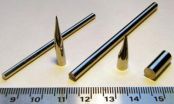(Press-News.org) Scientists dream of developing a real-world version of the Pied Piper's magic flute — new poisons that pose no threat to people, pets or wildlife, while specifically targeting rats, those germ-laden creatures that outnumber humans 6 to 1 in some urban areas. An article in the current edition of Chemical & Engineering News (C&EN), ACS' weekly newsmagazine, details some of the steps toward that goal.
C&EN Associate Editor Jyllian Kemsley points out that rats not only are notorious carriers of infectious disease, but threaten the survival of native plants and wildlife. Modern rat poisons, often based on anticoagulants, are effective. However, these substances can harm people and other animals and rats are developing resistance, so that they shrug off the effects of existing anticoagulants. The poisons thus may hurt other animals while leaving rats alive to continue their rampage.
The article explains that one of the major challenges today involves tracking whether and how much of a rodenticide is being consumed by rats or by other animals. Scientists are reporting progress on this front, which includes use of special fluorescent dyes to track how much bait rodents are eating and studying the fecal samples of their predators to identify contamination routes. Research also involves mutations in a gene that allows some rats to develop resistance to anticoagulants. These and other studies could lead to safer rat killers, the article suggests.
INFORMATION:
ARTICLE FOR IMMEDIATE RELEASE
"Regulating Rodents"
This story is available at
http://pubs.acs.org/cen/science/89/8902sci2.html
The quest for rat poisons that mimic the Pied Piper's magic flute
2011-01-13
ELSE PRESS RELEASES FROM THIS DATE:
Elastography helps identify patients who need biopsy
2011-01-13
A new ultrasound technique is proving valuable in distinguishing malignant from benign breast lesions in some patients – results that could mean fewer unnecessary breast biopsies, a new study shows.
The study found that ultrasound elastography, which indicates tissue softness, can help predict cancer in patients with BI-RADS category 4 masses. "Because malignant tumors predominantly are harder than benign tissues, this technique significantly improves the differentiation between benign and malignant tissue" said Hiroko Satake, MD, lead author of the study. Dr. Satake ...
Preoperative breast MRI suggests high cancer yield
2011-01-13
The use of preoperative Breast MRI detects otherwise occult cancer with a relatively high degree of accuracy when applied to a diverse population of patients newly diagnosed with breast cancer, according to a study in the January issue of the American Journal of Roentgenology.
The study was performed at the University of Washington and Seattle Cancer Care Alliance in Seattle, WA.
The review initiated with 592 patients who were recently diagnosed with breast cancer and underwent staging with preoperative breast MRI. The analysis set was comprised of 570 patients, whose ...
UBC-VCH researchers find critical link between Down syndrome and Alzheimer's disease
2011-01-13
Researchers at the University of British Columbia and Vancouver Coastal Health Research Institute have discovered that the genetic mechanism which destroys brain cells is responsible for early development of Alzheimer's Disease in people with Down Syndrome and for development of Alzheimer's Disease in general population – providing a potential new target for drugs that could forestall dementia in people with either condition.
The research, led by Dr. Weihong Song, Canada Research Chair in Alzheimer's Disease and a professor of psychiatry in the UBC Faculty of Medicine, ...
How children cope with the aftermath of a hurricane
2011-01-13
CORAL GABLES, FL (January 12, 2011) --Living through a natural disaster is a traumatic experience for everyone, but especially for children. A new study by University of Miami Psychologist Annette La Greca and her collaborators, indicate that some children who directly experience a devastating hurricane still show signs of posttraumatic stress (PTS) almmost two years after the event. The findings suggest that new models for intervention to help children after a natural disaster are needed.
The study, titled "Hurricane-Related Exposure Experiences and Stressors, Other Life ...
Middle school is when the right friends may matter most
2011-01-13
EUGENE, Ore. -- (Jan. 12, 2011) -- As adolescents move from elementary school into their middle or junior-high years, changes in friendships may signal potential academic success or troubles down the road, say University of Oregon researchers.
A new study, appearing in the February issue of the Journal of Early Adolescence, found that boys and girls whose friends are socially active in ways where rules are respected do better in their classroom work. Having friends who engage in problem behavior, in contrast, is related to a decrease in their grades. Having pro-social ...
Attention ladies and gentlemen: Courtship affects gene expression
2011-01-13
Scientists from Texas have made an important step toward understanding human mating behavior by showing that certain genes become activated in fruit flies when they interact with the opposite sex. This research, published in the January 2011 issue of the journal GENETICS (http://www.genetics.org), shows that courtship behaviors may be far more influenced by genetics than previously thought. In addition, understanding why and how these genes become activated within social contexts may also lead to insight into disorders such as autism.
"Be careful who you interact with," ...
Caltech-led team creates damage-tolerant metallic glass
2011-01-13
PASADENA, Calif.—Glass is inherently strong, but when it cracks or otherwise fails, it proves brittle, shattering almost immediately. Steel and other metal alloys tend to be tough—they resist shattering—but are also relatively weak; they permanently deform and fail easily.
The ideal material, says Marios Demetriou, a senior research fellow at the California Institute of Technology (Caltech), has the advantage of being both strong and tough—a combination called damage tolerance, which is more difficult to come by than the layperson might think. "Strength and toughness ...
23andMe presents top 10 most interesting genetic findings of 2010
2011-01-13
MOUNTAIN VIEW, CA – January 11, 2011 – 23andMe has released its first annual list of what it felt to be the 10 most interesting and significant genetic findings in 2010, as part of an ongoing journey to understand the role of genetics in personal health and human development.
"Our understanding of the human genome is accelerating at a phenomenal rate," stated Anne Wojcicki, co-founder and CEO of 23andMe. "Below we have compiled a list of our top ten favorite genetic discoveries from 2010. We look forward to exploring more discoveries in 2011."
Customers of 23andMe ...
New method will triple amount of genetic information from newborn blood spot screenings
2011-01-13
Grand Rapids, Mich. (January 12, 2011) – Van Andel Research Institute (VARI) researchers have developed a method that can yield more information from archived newborn blood that has implications for a vast array of research, including population health studies and answering questions about diseases in infants and children.
In a recent study published in Pathology International, VARI researchers detected approximately 9,000 activated genes in samples from adult blood spots on Guthrie cards that had been archived anywhere from six months to three years. Researchers say ...
Natural dissolved organic matter plays dual role in cycling of mercury
2011-01-13
Nature has a bit of a Jekyll and Hyde relationship with mercury, but researchers at the Department of Energy's Oak Ridge National Laboratory have made a discovery that ultimately could help explain the split personality.
While scientists have known that microbes in aquatic environments make methylmercury, a more toxic form of mercury that accumulates in fish, they also know that nature and other types of bacteria can transform methylmercury to less toxic forms. What they haven't completely understood are the mechanisms that cause these transformations in anoxic environments ...


